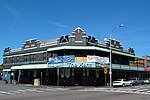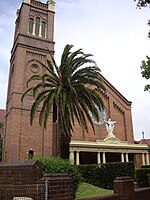Newcastle, New South Wales

Newcastle (locally NEW-kass-əl; Awabakal: Mulubinba) is a metropolitan area and the second most populated city in the state of New South Wales, Australia. It includes the Newcastle and Lake Macquarie local government areas, and is the hub of the Greater Newcastle area, which includes most parts of the local government areas of City of Newcastle, City of Lake Macquarie, City of Cessnock, City of Maitland and Port Stephens Council.Located at the mouth of the Hunter River, it is the predominant city within the Hunter Region. Famous for its coal, Newcastle is the largest coal exporting harbour in the world, exporting 159.9 million tonnes of coal in 2017. Beyond the city, the Hunter Region possesses large coal deposits. Geologically, the area is located in the central-eastern part of the Sydney Basin.
Excerpt from the Wikipedia article Newcastle, New South Wales (License: CC BY-SA 3.0, Authors, Images).Newcastle, New South Wales
Morgan Street, Newcastle-Maitland Islington
Geographical coordinates (GPS) Address Nearby Places Show on map
Geographical coordinates (GPS)
| Latitude | Longitude |
|---|---|
| N -32.916666666667 ° | E 151.75 ° |
Address
Hair Space
Morgan Street
2296 Newcastle-Maitland, Islington
New South Wales, Australia
Open on Google Maps






